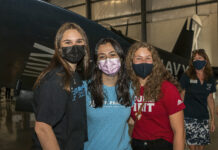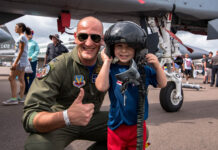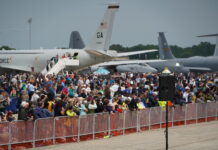Though the air show community does quite a good job at recognizing its individual professionals with awards and prizes each year, there is – surprisingly – no award for best air show. Objective criteria would be difficult – if not impossible – to develop and the definition of “best” would likely differ significantly from one person to the next. So, as an industry, we simply don’t formally recognize our finest events.
But, in this centennial of flight year, it’s useful to take special note of the air show that was held in Dayton, Ohio this past July.
The show itself was spectacular, with 40 hours of flying by 75 different aircraft – including all three North American military jet teams — over a four-day weekend in mid-July. The event was blessed with picture-perfect weather, immense crowds and a local community that supported the show in every respect. Reviews by those both inside and outside the air show business have been uniformly positive. We’ve included a six-page photo essay on the show to highlight some of the show’s more interesting aspects.
But this was more than just a great air show; it was an event that gave our industry a blueprint for air show success that we should be learning from for many years to come. This year’s Dayton Air Show should also provide every air show event organizer, performer and concessionaire with a sense of hope about the future of our business.
When asked to comment on this year’s show, long-time ICAS member and Dayton Air Show executive director Chuck Newcomb observed that the show, “…was a case of all the ‘success’ elements crossing and lining up in an unusual way, contributed to by ten years of community discussion followed by three focused years of staff work, Board work and planning, topped off by ‘century perfect’ weather…and a lot of support, both internal and external.”
Newcomb believes that the elements that made the 2003 Dayton Air Show successful are essential elements for any successful air show. First, you need to offer the public a quality, entertaining event. The event should be financially self-sufficient with budgeted expenses not greater than 80 percent of expected revenue on a good, but not great weekend, and a cash reserve equivalent to one-half of the show’s annual operating costs. And the air show should meet the community’s objectives and be integrated in such a way that the show is considered a community asset.
Put a different way, the air show business should be run like a business whether it’s an entrepreneurial money-making venture, a non-profit effort to raise money for a scholarship fund or a public relations project to increase interest in and awareness of a community airport.
With all the hoopla surrounding Dayton’s celebration of the anniversary of flight, it would have been easy for show organizers to over-extend themselves. There was no scarcity of innovative, interesting, exciting ideas, but – at every turn – show management reined in their enthusiasm and continually refocused on the need to run the air show business as a business even as they worked and planned to deliver an appropriately spectacular celebration of the 100th anniversary of flight.
In Dayton, the result of this planning and discipline was an air show that did not get carried away with itself despite the endless opportunities its organizers had to do so…an air show that stayed within its budget and met or exceeded all financial projections…an air show that showcased for the entire world just how exciting, entertaining and safe an air show can be…an air show that was comfortable enough with its own success and the accuracy of its record keeping to report a four-day attendance of 160,000 even though shows with half as many people regularly report crowds four times as large…an air show that lived up to its considerable potential and provided the rest of us with reason to be optimistic about the air show industry’s future and its capacity to profitably inspire, educate and entertain.








